- Cryptocaryon
-
Cryptocaryon irritans Scientific classification Domain: Eukarya Kingdom: Chromalveolata Superphylum: Alveolata Phylum: Ciliophora Class: Prostomatea Genus: Cryptocaryon Species: C. irritans Binomial name Cryptocaryon irritans Cryptocaryon irritans (also known as marine white spot disease or marine ich[1]) is a species of ciliate protozoa that parasitizes marine fish, and is one of the most common causes of disease in marine aquaria.
Contents
Taxonomy
Cryptocaryon irritans was originally classified as Ichthyophthirius marinus, but it is not closely related to the other species. It belongs to the class Prostomatea, but beyond that its placement is still uncertain.
Clinical
The symptoms and life-cycle are generally similar to those of Ichthyophthirius in freshwater fish, including white spots, on account of which Cryptocaryon is usually called marine ich. However, Cryptocaryon can spend a much longer time encysted.
Useful treatments of Cryptocaryon irritans are copper solutions, formalin solutions and quinine based drugs (such as Chloroquine Phosphate and Quinine Diphosphate).
Infections can be extremely difficult to treat because of other creatures, such as corals and other invertebrates, which will not survive standard treatments. Ideally fish with Cryptocaryon are quarantined in a hospital tank, where they can be treated with a copper salt or using hyposalinity. The display tank needs to be kept clear of fish for 6-9 weeks, the longer the better. This gives time for the encysted tomonts to release infectious theronts, which die within 24-48 hours when they cannot find a host.
References
- ^ Noga. Fish Disease: Diagnosis and Treatment. 2000.
Noga, Edward J. (2000). Fish disease: diagnosis and treatment. Wiley-Blackwell. pp. 97–99. ISBN 9780813825588.
External links
Ciliophora Spirotrichea (Stylonychia) · Litostomatea (Didinium, Balantidium) · Phyllopharyngea (Tokophrya) · Nassophorea (Nassula) · Colpodea (Colpoda) · Oligohymenophorea (Tetrahymena, Ichthyophthirius, Vorticella, Paramecium) · Plagiopylea (Plagiopyla) · Prostomatea (Coleps)OtherCryptocaryonMyzozoa Plasmodiidae/Haemosporida (Plasmodium, Haemoproteus, Leucocytozoon)
Piroplasmida (Babesia, Theileria)Adele-Haemogregarina, Hepatozoon, KaryolysusEimeri-Cryptosporidiidae (Cryptosporidium)
Eimeriidae (Isospora, Cyclospora, Eimeria)
Sarcocystidae (Toxoplasma, Sarcocystis, Besnoitia, Neospora)Agamo-Rhytidocystidae (Rhytidocystis)GregariniaGregarinasina (Gregarina)ColpodellidaeChromeridaChromera velia, Vitrella brassicaformisWith a theca: Peridiniales (Pfiesteria, Peridinium) · Gonyaulacales (Ceratium, Gonyaulax) · Prorocentrales (Prorocentrum) · Dinophysiales (Dinophysis, Histioneis, Ornithocercus, Oxyphysis)
Without theca: Gymnodiniales (Gymnodinium, Karenia, Karlodinium, Amphidinium) · Suessiales (Polarella, Symbiodinium)
Noctilucales (Noctiluca)Syndiniales: Amoebophryaceae (Amoebophyra) · Duboscquellaceae (Duboscquella) · Syndiniaceae (Hematodinium, Syndinium)OtherRelatedPathogens - Aeromonas salmonicida
- Columnaris
- Enteric redmouth
- Fin rot
- Fish dropsy
- Flavobacterium
- Hematopoietic necrosis
- Heterosigma akashiwo
- Hole in the head
- Hypodermal and hematopoietic necrosis
- Infectious pancreatic necrosis
- Koi herpes virus
- Novirhabdovirus
- Pfiesteria piscicida
- Photobacterium damselae ssp piscicida
- Salmon anemia
- Streptococcus iniae
- Taura syndrome
- UDN
- VHS
- White spot
- Yellowhead

Parasites - Abergasilus
- Amoebic gill disease
- Carp lice
- Ceratomyxa shasta
- Dactylogyrus vastator
- Diphyllobothrium
- Epizootic ulcerative syndrome
- Flukes
- Glugea
- Gyrodactylus salaris
- Henneguya zschokkei
- Ich (freshwater)
- Ich (marine)
- Kudoa thyrsites
- Lernaeocera branchialis
- Myxobolus cerebralis
- Nanophyetus salmincola
- Salmon lice
- Saprolegnia
- Schistocephalus solidus
- Sea louse
- Sphaerothecum destruens
- Swim bladder disease
- Tetracapsuloides bryosalmonae
- Velvet
Related topics Categories:- Fishkeeping stubs
- Ciliates
- Fish diseases
- Veterinary protozoology
Wikimedia Foundation. 2010.
